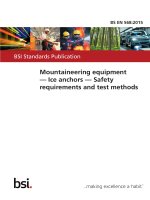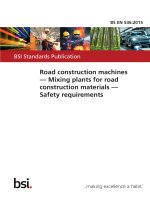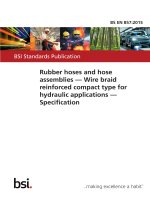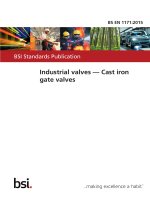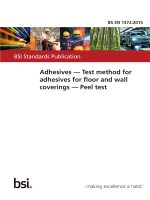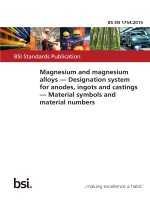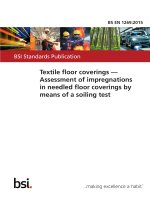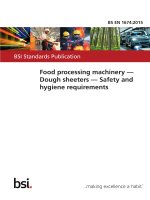Bsi bs en 00448 2015
Bạn đang xem bản rút gọn của tài liệu. Xem và tải ngay bản đầy đủ của tài liệu tại đây (1.54 MB, 34 trang )
BS EN 448:2015
BSI Standards Publication
District heating pipes —
Preinsulated bonded pipe
systems for directly buried
hot water networks — Fitting
assemblies of steel service
pipes, polyurethane thermal
insulation and outer casing of
polyethylene
BS EN 448:2015
BRITISH STANDARD
National foreword
This British Standard is the UK implementation of EN 448:2015.
It supersedes BS EN 448:2009 which is withdrawn.
The UK participation in its preparation was entrusted to Technical
Committee RHE/9, Insulated underground pipelines.
A list of organizations represented on this committee can be
obtained on request to its secretary.
This publication does not purport to include all the necessary
provisions of a contract. Users are responsible for its correct
application.
© The British Standards Institution 2015.
Published by BSI Standards Limited 2015
ISBN 978 0 580 85227 5
ICS 23.040.40
Compliance with a British Standard cannot confer immunity from
legal obligations.
This British Standard was published under the authority of the
Standards Policy and Strategy Committee on 30 November 2015.
Amendments/corrigenda issued since publication
Date
Text affected
BS EN 448:2015
EN 448
EUROPEAN STANDARD
NORME EUROPÉENNE
EUROPÄISCHE NORM
November 2015
ICS 23.040.40
Supersedes EN 448:2009
English Version
District heating pipes - Preinsulated bonded pipe systems for
directly buried hot water networks - Fitting assemblies of steel
service pipes, polyurethane thermal insulation and outer casing
of polyethylene
Tuyaux de chauffage urbain - Systèmes bloqués de tuyaux
préisolés pour des réseaux d'eau chaude enterrés
directement - Raccords préisolés pour tubes de service en
acier, isolation thermique en polyuréthane et tube de
protection en polyéthylène
Fernwärmerohre - Werkmäßig gedämmte
Verbundmantelrohrsysteme für direkt erdverlegte
Fernwärmenetze - Verbundformstücke, bestehend aus
Stahl-Mediumrohr, Polyurethan-Wärmedämmung und
Außenmantel aus Polyethylen
This European Standard was approved by CEN on 5 September 2015.
CEN members are bound to comply with the CEN/CENELEC Internal Regulations which stipulate the conditions for giving this European
Standard the status of a national standard without any alteration. Up-to-date lists and bibliographical references concerning such national
standards may be obtained on application to the CEN-CENELEC Management Centre or to any CEN member.
This European Standard exists in three official versions (English, French, German). A version in any other language made by translation
under the responsibility of a CEN member into its own language and notified to the CEN-CENELEC Management Centre has the same
status as the official versions.
CEN members are the national standards bodies of Austria, Belgium, Bulgaria, Croatia, Cyprus, Czech Republic, Denmark, Estonia,
Finland, Former Yugoslav Republic of Macedonia, France, Germany, Greece, Hungary, Iceland, Ireland, Italy, Latvia, Lithuania,
Luxembourg, Malta, Netherlands, Norway, Poland, Portugal, Romania, Slovakia, Slovenia, Spain, Sweden, Switzerland, Turkey and United
Kingdom.
EUROPEAN COMMITTEE FOR STANDARDIZATION
COMITÉ EUROPÉEN DE NORMALISATION
EUROPÄISCHES KOMITEE FÜR NORMUNG
CEN-CENELEC Management Centre: Avenue Marnix 17, B-1000 Brussels
© 2015 CEN
All rights of exploitation in any form and by any means reserved
worldwide for CEN national Members.
Ref. No. EN 448:2015 E
BS EN 448:2015
EN 448:2015 (E)
Contents
Page
European foreword....................................................................................................................................................... 4
Introduction .................................................................................................................................................................... 5
1
Scope .................................................................................................................................................................... 6
2
Normative references .................................................................................................................................... 6
3
Terms and definitions ................................................................................................................................... 8
4
4.1
4.1.1
4.1.2
4.1.3
4.1.4
4.1.5
4.1.6
4.1.7
4.1.8
4.1.9
4.1.10
4.1.11
4.2
4.3
4.4
4.4.1
4.4.2
4.4.3
4.4.4
4.4.5
4.4.6
4.4.7
4.5
Requirements ................................................................................................................................................ 10
Steel parts ....................................................................................................................................................... 10
General ............................................................................................................................................................. 10
Quality .............................................................................................................................................................. 10
Wall thickness and diameter ................................................................................................................... 10
Bends ................................................................................................................................................................ 10
T-pieces............................................................................................................................................................ 11
Reducers .......................................................................................................................................................... 12
Anchors ............................................................................................................................................................ 12
Single use compensators ........................................................................................................................... 12
Caps ................................................................................................................................................................... 12
Fusion welding of steel fittings ............................................................................................................... 12
Surface condition ......................................................................................................................................... 14
Casing ............................................................................................................................................................... 15
Polyurethane rigid foam insulation (PUR) ......................................................................................... 15
Fitting assemblies ........................................................................................................................................ 15
Fitting ends ..................................................................................................................................................... 15
Angle between casing segments of bend and minimum length................................................... 15
Requirements of polyethylene welding ............................................................................................... 16
Leak-tightness of the welded casing pipe............................................................................................ 17
Diameter and wall thickness of the casing.......................................................................................... 18
Minimum insulation thickness in bends.............................................................................................. 18
Tolerances of the main fitting dimensions ......................................................................................... 18
Surveillance system..................................................................................................................................... 18
5
5.1
5.2
5.3
5.3.1
5.3.2
5.3.3
5.3.4
5.3.5
5.4
5.5
5.6
5.6.1
5.6.2
5.6.3
5.6.4
5.7
Test methods ................................................................................................................................................. 18
General ............................................................................................................................................................. 18
Test specimens .............................................................................................................................................. 19
Steel parts ....................................................................................................................................................... 19
Visual surface examination of welds ..................................................................................................... 19
Leak-tightness test with water ................................................................................................................ 19
Leak-tightness test with air ...................................................................................................................... 19
Non-destructive examination of welds ................................................................................................ 19
NDT of welds .................................................................................................................................................. 20
Casing ............................................................................................................................................................... 20
Polyurethane rigid foam insulation (PUR) ......................................................................................... 20
Fitting assemblies ........................................................................................................................................ 20
Centre line deviation and angular deviation...................................................................................... 20
Visual examination of welds on casing pipes ..................................................................................... 20
Bending test ................................................................................................................................................... 20
Minimum insulation thickness ................................................................................................................ 21
Surveillance system..................................................................................................................................... 21
2
BS EN 448:2015
EN 448:2015 (E)
6
6.1
6.2
6.3
6.4
6.5
Marking ............................................................................................................................................................ 21
General ............................................................................................................................................................. 21
Steel service pipe .......................................................................................................................................... 21
Casing ................................................................................................................................................................ 22
Fitting assembly ............................................................................................................................................ 22
Single use compensators ............................................................................................................................ 22
Annex A (informative) Guidelines for inspection and testing ..................................................................... 23
A.1
General ............................................................................................................................................................. 23
A.2
Manufacturer’s type test ............................................................................................................................ 23
A.3
Manufacturer’s quality control ................................................................................................................ 23
A.4
External inspection ...................................................................................................................................... 23
A.5
Extent of inspection ..................................................................................................................................... 23
A.6
Manufacturer’s responsibility ................................................................................................................. 23
Annex B (informative) Procedures for polyethylene welding..................................................................... 26
B.1
General ............................................................................................................................................................. 26
B.2
Recommendations for site, machine and equipment ...................................................................... 26
B.3
Items .................................................................................................................................................................. 26
B.4
Butt fusion welding ...................................................................................................................................... 26
B.5
Extrusion welding......................................................................................................................................... 28
Bibliography ................................................................................................................................................................. 30
3
BS EN 448:2015
EN 448:2015 (E)
European foreword
This document (EN 448:2015) has been prepared by Technical Committee CEN/TC 107 “Prefabricated
district heating and district cooling pipe system”, the secretariat of which is held by DS.
This European Standard shall be given the status of a national standard, either by publication of an identical
text or by endorsement, at the latest by May 2016, and conflicting national standards shall be withdrawn at
the latest by May 2016.
Attention is drawn to the possibility that some of the elements of this document may be the subject of patent
rights. CEN [and/or CENELEC] shall not be held responsible for identifying any or all such patent rights.
This document supersedes EN 448:2009.
According to the CEN/CENELEC Internal Regulations, the national standards organizations of the following
countries are bound to implement this European Standard: Austria, Belgium, Bulgaria, Croatia, Cyprus, Czech
Republic, Denmark, Estonia, Finland, Former Yugoslav Republic of Macedonia, France, Germany, Greece,
Hungary, Iceland, Ireland, Italy, Latvia, Lithuania, Luxembourg, Malta, Netherlands, Norway, Poland,
Portugal, Romania, Slovakia, Slovenia, Spain, Sweden, Switzerland, Turkey and the United Kingdom.
4
BS EN 448:2015
EN 448:2015 (E)
Introduction
EN 448 has been aligned with EN 488 and other relevant European Standards.
Other standards from CEN/TC 107 are:
— EN 253, District heating pipes — Preinsulated bonded pipe systems for directly buried hot water
networks — Pipe assembly of steel service pipe, polyurethane thermal insulation and outer casing of
polyethylene;
— EN 488, District heating pipes — Preinsulated bonded pipe systems for directly buried hot water
networks — Steel valve assembly for steel service pipes, polyurethane thermal insulation and outer casing
of polyethylene;
— EN 489, District heating pipes — Preinsulated bonded pipe systems for directly buried hot water
networks — Joint assembly for steel service pipes, polyurethane thermal insulation and outer casing of
polyethylene;
— EN 13941, Design and installation of preinsulated bonded pipe systems for district heating;
— EN 14419, District heating pipes — Preinsulated bonded pipe systems for directly buried hot water
networks — Surveillance systems;
— EN 15632 (all parts), District heating pipes — Pre-insulated flexible pipe systems;
— EN 15698-1, District heating pipes — Preinsulated bonded twin pipe systems for directly buried hot water
networks — Part 1: Twin pipe assembly of steel service pipe, polyurethane thermal insulation and outer
casing of polyethylene;
— EN 15698-2, District heating pipes — Preinsulated bonded pipe systems for directly buried hot water
networks — Fitting assemblies of steel service pipes, polyurethane thermal insulation and outer casing of
polyethylene.
5
BS EN 448:2015
EN 448:2015 (E)
1 Scope
This European Standard specifies requirements and test methods for fittings of prefabricated thermally
insulated pipe-in-pipe assemblies comprising a steel service fitting from DN 20 to DN 1200, rigid
polyurethane foam insulation and an outer casing of polyethylene for use in directly buried hot water
networks with preinsulated pipe assemblies in accordance with EN 253.
This European Standard covers the following fittings: bend, tee, reducer, single use compensator and anchor.
This European Standard applies only to factory made prefabricated fitting assemblies and single use
compensators for continuous operation with hot water at various temperatures in accordance with EN 253.
This European Standard applies to fitting assemblies with a minimum design pressure of 16 bar
(overpressure) complying with EN 13941.
This European Standard does not include calculation rules for loads and stresses. The design and installation
rules, for the system, are given in EN 13941.
2 Normative references
The following documents, in whole or in part, are normatively referenced in this document and are
indispensable for its application. For dated references, only the edition cited applies. For undated references,
the latest edition of the referenced document (including any amendments) applies.
EN 253:2009+A2:2015, District heating pipes — Preinsulated bonded pipe systems for directly buried hot
water networks — Pipe assembly of steel service pipe, polyurethane thermal insulation and outer casing of
polyethylene
EN 489:2009, District heating pipes — Preinsulated bonded pipe systems for directly buried hot water
networks — Joint assembly for steel service pipes, polyurethane thermal insulation and outer casing of
polyethylene
EN 10216-2, Seamless steel tubes for pressure purposes — Technical delivery conditions — Part 2: Non-alloy
and alloy steel tubes with specified elevated temperature properties
EN 10217-1, Welded steel tubes for pressure purposes — Technical delivery conditions — Part 1: Non-alloy
steel tubes with specified room temperature properties
EN 10217-2, Welded steel tubes for pressure purposes — Technical delivery conditions — Part 2: Electric
welded non-alloy and alloy steel tubes with specified elevated temperature properties
EN 10217-5, Welded steel tubes for pressure purposes — Technical delivery conditions — Part 5: Submerged
arc welded non-alloy and alloy steel tubes with specified elevated temperature properties
EN 10253-2, Butt-welding pipe fittings — Part 2: Non alloy and ferritic alloy steels with specific inspection
requirements
EN 12814-1, Testing of welded joints of thermoplastics semi-finished products — Part 1: Bend test
EN 13018, Non-destructive testing — Visual testing — General principles
EN 13941, Design and installation of preinsulated bonded pipe systems for district heating
EN 14419:2009, District heating pipes — Preinsulated bonded pipe systems for directly buried hot water
networks — Surveillance systems
EN 14870-1, Petroleum and natural gas industries — Induction bends, fittings and flanges for pipeline
transportation systems — Part 1: Induction bends (ISO 15590-1:2009 modified)
6
BS EN 448:2015
EN 448:2015 (E)
EN ISO 3452-1, Non-destructive testing — Penetrant testing — Part 1: General principles (ISO 3452-1)
EN ISO 5579, Non-destructive testing — Radiographic testing of metallic materials using film and X- or gamma
rays — Basic rules (ISO 5579)
EN ISO 5817, Welding — Fusion-welded joints in steel, nickel, titanium and their alloys (beam welding
excluded) — Quality levels for imperfections (ISO 5817)
EN ISO 8501-1, Preparation of steel substrates before application of paints and related products — Visual
assessment of surface cleanliness — Part 1: Rust grades and preparation grades of uncoated steel substrates
and of steel substrates after overall removal of previous coatings (ISO 8501-1)
EN ISO 9606-1, Qualification testing of welders — Fusion welding — Part 1: Steels (ISO 9606-1)
EN ISO 9692-1:2013, Welding and allied processes — Types of joint preparation — Part 1: Manual metal arc
welding, gas-shielded metal arc welding, gas welding, TIG welding and beam welding of steels (ISO 96921:2013)
EN ISO 9934-1, Non-destructive testing — Magnetic particle testing — Part 1: General principles (ISO 9934-1)
EN ISO 10675-1, Non-destructive testing of welds — Acceptance levels for radiographic testing — Part 1: Steel,
nickel, titanium and their alloys (ISO 10675-1)
EN ISO 11666, Non-destructive testing of welds — Ultrasonic testing — Acceptance levels (ISO 11666)
EN ISO 14732, Welding personnel — Qualification testing of welding operators and weld setters for
mechanized and automatic welding of metallic materials (ISO 14732)
EN ISO 15607, Specification and qualification of welding procedures for metallic materials — General rules
(ISO 15607)
EN ISO 16810, Non-destructive testing — Ultrasonic testing — General principles (ISO 16810)
EN ISO 17636-1, Non-destructive testing of welds — Radiographic testing — Part 1: X- and gamma-ray
techniques with film (ISO 17636-1)
EN ISO 17636-2, Non-destructive testing of welds — Radiographic testing — Part 2: X- and gamma-ray
techniques with digital detectors (ISO 17636-2)
EN ISO 17637, Non-destructive testing of welds — Visual testing of fusion-welded joints (ISO 17637)
EN ISO 17638, Non-destructive testing of welds — Magnetic particle testing (ISO 17638)
EN ISO 17640, Non-destructive testing of welds — Ultrasonic testing — Techniques, testing levels, and
assessment (ISO 17640)
EN ISO 23277, Non-destructive testing of welds — Penetrant testing — Acceptance levels (ISO 23277)
EN ISO 23278, Non-destructive testing of welds — Magnetic particle testing — Acceptance levels (ISO 23278)
7
BS EN 448:2015
EN 448:2015 (E)
3 Terms and definitions
For the purposes of this document, the terms and definitions given in EN 253:2009+A2:2015 and the
following apply.
3.1
anchor
construction used to transfer the loads from the steel service pipe through the insulation and the casing to a
fixed point
3.2
bending angle
α
deviation in direction of the steel pipe centre lines
3.3
butt welded bend
bend manufactured either by hot bending of steel pipe or by hot forming of steel plates which are
subsequently welded together
3.4
cold formed bend
bend manufactured by cold bending of steel pipe
3.5
cap
not pre-insulated butt welded fitting to be welded on the end of a pipe or fitting
3.6
fitting
reducer, tee, factory-made elbow and bend, cap, welding stub, mechanical joint
3.7
forged T-piece
T-piece manufactured by hot forming of either steel pipes or steel plates which are subsequently welded
together
3.8
hot formed bend
bend manufactured by heating pipe during bending
3.9
induction bend
bend manufactured by induction bending
3.10
induction bending
continuous bending process which utilizes induction heating to create a narrow, circumferential, heated
band around the material being bent
3.11
nominal size, DN
alphanumeric designation of size, common to components in piping systems which are used for reference
purposes
[SOURCE: EN ISO 6708:1995, 2.1, modified]
8
BS EN 448:2015
EN 448:2015 (E)
3.12
pipe element
reducer, tee, factory-made elbow and bend, flange, cap, welding stub, mechanical joint
3.13
reducer
butt welding fitting to be welded between two steel pipes of different diameters
3.14
single use compensator
SUC
compensator functioning during pre-heating, but being locked after pre-heating
NOTE
Single use compensators are not preinsulated units.
3.15
surveillance system
system that consists of measuring sections and measuring instruments for surveillance of pipe systems
according to EN 14419:2009
3.16
welded tee
butt welding fitting manufactured by welding together pieces of steel pipes with or without the use of a
welding saddle or a drawn collar on the main pipe
3.17
welding saddle
butt welding fitting to be welded into the main pipe for the welded connection between the main pipe and
the branch pipe in a T-piece
Key
a
cold or hot formed bends
e
tee with welding saddle
c
bending angle, α
g
directly welded tee
b
d
butt welding bend or elbows
forged tee
f
tee with drawn collar
Figure 1 — Examples
9
BS EN 448:2015
EN 448:2015 (E)
4 Requirements
4.1 Steel parts
4.1.1 General
The material of the fitting steel parts shall be certified in accordance with EN 10204. If traceability on
material is required by the end user it shall be specified at the time of ordering. Corresponding material
certificates shall be delivered to the end user if specified at the time of ordering.
4.1.2 Quality
The quality of pipe material used for the assembly of fittings shall be in accordance with
EN 253:2009+A2:2015, Table 1. The quality of butt welding pipe fittings shall be in accordance with
EN 10253-2.
NOTE
For Sweden, a deviating situation is applicable for EN 253:2009+A2:2015, Table 1 (see the A-deviation in
EN 253:2009+A2:2015, Annex G).
4.1.3 Wall thickness and diameter
According to the scope of this European Standard, all components shall be designed for a minimum of 16 bar.
NOTE
If the fitting assemblies have to be used in situations with pressures higher than 16 bar, extra calculations
will be necessary.
The minimum nominal wall thickness of all components shall prior to processing be at least the same as for
the straight pipes.
The nominal diameter, the outside diameter and the minimum nominal wall thickness shall be the same as
for the straight pipes in accordance with EN 253:2009+A2:2015, Table 2. The tolerances on the outside
diameter of the pipe ends shall be in accordance with EN 253:2009+A2:2015, Table 3.
Subject to design considerations other wall thicknesses than those given in EN 253:2009+A2:2015, Table 2
may be used, but in no case shall these be less than the minima indicated in EN 253:2009+A2:2015, Table 2.
All components shall be designed in accordance with EN 13941, for the actions and stresses that normally
occur during a system's entire service life.
4.1.4 Bends
4.1.4.1 Butt welding bends
The dimensions shall be in accordance with EN 10253-2 with the exception that the bend radius shall
be ≥ 1,5 times the outer diameter.
4.1.4.2 Cold formed bends
Cold formed bends shall be produced from seamless pipe or longitudinal welded pipes. At cold formed bends
made of longitudinal welded pipes the weld bead shall be welded to factor V = 1 (calculation stress = 100 %).
After bending, the minimum wall thickness of the bent pipe shall be not less than 85 % of the nominal wall
thickness of the straight pipe (see EN 253:2009+A2:2015, Table 2).
The maximum ovality in the bent area shall not exceed 6 %.
The formula for the calculation of the ovality is:
o
where
10
( Ds max − Ds min ) × 100
Ds
(1)
BS EN 448:2015
EN 448:2015 (E)
o
Ds max
Ds min
Ds
is the ovality, in %;
is the maximum outside diameter;
is the minimum outside diameter in the same cross section in the bended area;
is the specified outside diameter.
There shall be no folding in the bent area. Waves can be accepted, when the maximum height between
trough and crest of the wave does not exceed 25 % of the nominal wall thickness of the bent pipe.
4.1.4.3 Hot-formed bends
For hot-formed bends manufactured from straight pipes by means of inductive heating (induction bends), no
heat treatment is necessary as far as this method is applied with unalloyed or low-alloyed steel with
[Mo] < 0,65 %. Hot-formed bends shall be supplied in conformity with EN 14870-1.
If for the bending other heating methods are applied, heat treatment following the bending of the pipes is
required.
If a hot-formed bend has to be made from line pipe, this should be specified to the pipe manufacturer at the
time of ordering so that they can take this into account when selecting the (chemical) composition of the
pipe material and the welding filler material.
It is recommended to determine per batch, diameter, wall thickness and bend radius, through mechanical
testing, that the bends comply with the applicable material specifications. It is customary that a
representative bend or an (additional) section of a bend of adequate length be manufactured during the
production process and that 10 % of the bends be tested.
4.1.4.4 Tolerances of bending angles
The deviation from the nominal bending angle shall not exceed the tolerances given in Table 1.
Table 1 — Deviations from nominal bending angle
4.1.5 T-pieces
Nominal diameter of
service pipe
Deviation
≤ DN 200
±2,0°
> DN 200
±1,0°
4.1.5.1 Forged T-pieces
The wall thickness T and T1, see EN 10253-2, shall be at least the same as those for the straight pipes, see
EN 253:2009+A2:2015, Table 2. All other dimensions shall be in accordance with EN 10253-2.
4.1.5.2 Welding saddles
Welding saddles shall be of the type which shall be welded into the wall of the main pipe.
The wall thickness of the welding saddles shall be at least the same as the wall thicknesses of the main pipes
and the branch pipes which shall be welded to the saddles.
4.1.5.3 Welded T-pieces
Welded T-pieces shall be manufactured either by using welding saddles or by drawing a collar on which the
branch pipe is welded or by welding the branch pipe directly to the main pipe. The wall thickness of the
collar shall be at least the same as that for the branch pipe, see EN 253:2009+A2:2015, Table 2. The collar
shall be drawn opposite the welding seam in the main pipe. When using branch pipe directly welded to the
main pipe, compensating (reinforcement) plates can be used according to EN 13941 requirements.
11
BS EN 448:2015
EN 448:2015 (E)
4.1.5.4 Tolerances of angles between branch pipes and main pipes
The branch pipes shall be perpendicular to the main pipes within a tolerance of ± 2,0°.
4.1.6 Reducers
Reducers shall be in accordance with EN 10253-2, except for the wall thicknesses T and T1, see EN 10253-2
which shall be at least the same as for the straight pipes (see EN 253:2009+A2:2015, Table 2) to be welded
to the fittings.
4.1.7 Anchors
The anchors shall be marked with the information concerning maximum loads for which the construction
was designed and calculated. The lifetime of the system shall not be influenced by the anchors construction.
4.1.8 Single use compensators
A single use compensator shall comply with the requirements of EN 13941.
4.1.9 Caps
Caps (dished ends) shall be in accordance with EN 10253-2 and comply with the requirements of EN 13941.
4.1.10 Fusion welding of steel fittings
4.1.10.1 Filler material
Filler material shall after welding have mechanical characteristics comparable with the parent metal.
4.1.10.2 Welding process
All types of fusion welding are acceptable but arc welding with covered electrodes and gas-shielded metalarc welding are preferred. The welding process shall be specified and approved in accordance with
EN ISO 15607.
The method of approval may be chosen by the manufacturer.
Fittings of wall thickness ≥ 5,6 mm shall be welded in more than one pass.
4.1.10.3 Preparation for welding
Pipe ends shall be prepared in accordance with the welding procedure used. When using covered electrodes
or gas-shielded metal-arc welding, pipe ends and fittings with equal wall thickness shall be prepared in
accordance with EN ISO 9692-1.
Table 2 of this standard is derived from EN ISO 9692-1:2013, Table 1 and gives the relation between wall
thickness and reference number.
Table 2 — Preparation of ends of pipes and fittings for weldings according to EN ISO 9692-1:2013
Symbol
II
V
Y
NOTE
Type of preparation
Wall thickness T of service pipe
fittings or fitting end
Square preparation
T < 3 mm
Single Y preparation with
broad root face
T > 10 mm
Single V preparation
3 mm ≤ T ≤ 10 mm
Symbols are in accordance with ISO 2553.
Reference to
EN ISO 9692-1:2013, Table 1
1.2.1
1.3
1.5
Pipe ends and fittings with different wall thicknesses shall be prepared and adapted for misalignment in
accordance with Table 3 and Figure 2 of this standard.
12
BS EN 448:2015
EN 448:2015 (E)
Table 3 — Adaptation of misalignment and difference in wall thickness
Adaptation
Required action
Misalignment
Misalignment h ≤ 0,3 t, max. 1 mm
Figure 2 detail A
Misalignment h > 10 mm
Extra fitting
Misalignment 1 mm < h ≤ 10 mm
Difference in wall thickness
Differences in wall thickness: t' ≤ 1,5 tn
Differences in wall thickness: t' > 1,5 tn
Figure 2 detail B
Figure 2 detail C
Adaptation of pipe ends
Extra prepared steel fitting minimum
length, see note
Adaptation of thicker wall t'
Adaptation of both sides
The seam spacing shall be such that the heat-affected zones do not overlap or interact. A spacing of 100 mm
or more is recommended. The minimum spacing is 50 mm.
Key
h
misalignment
t’
largest wall thickness
tn
smallest wall thickness
Figure 2 — Misalignment, difference in wall thickness and joint end preparation, in accordance with
EN 13941
When manufacturing T-pieces with the branch pipe welded directly to the main pipe, preparations shall
comply with Figure 3.
13
BS EN 448:2015
EN 448:2015 (E)
Key
a
b
section X at crotch of right angle branch
c
section Y at flank of unequal branch. Ratios of
diameters ≤ 2/3.
d
section W at flank of equal branch.
section Y at flank of unequal branch. Ratios of
diameters > 2/3.
Figure 3 — Preparation of set-on branches
4.1.10.4 Inspection of welds
4.1.10.4.1 Detail a – Visual surface examination
When visual surface examination is carried out, it shall be in accordance with 5.3.1. The examinations
include a check of surface, internal, joint geometry and multiple imperfections. The welding shall comply
with “quality level B” of EN ISO 5817.
4.1.10.4.2 Detail b – Leak tightness test
When a leak-tightness test is carried out in accordance with 5.3.2 or 5.3.3, the welds shall fulfil the
conditions stated there.
4.1.10.4.3 Detail c – Non-destructive examination of welds
When non-destructive is carried out, it shall be in accordance with 5.3.4. The weld shall comply with
“quality level B” of EN ISO 5817.
4.1.10.5 Competence of the welder
The welder shall have a valid certificate according to EN ISO 9606-1 for the techniques, material groups,
dimension ranges and welding position concerned. Welding personnel operating mechanized welding
equipment shall be qualified in accordance with EN ISO 14732.
4.1.11 Surface condition
In order to ensure proper bonding between the steel service pipe and the PUR-foam insulation, the following
procedure shall be followed:
a) prior to insulation, the outer surface of the pipe shall be cleaned so that it is free from rust, mill scale, oil,
grease, dust, paint, moisture and other contaminants;
14
BS EN 448:2015
EN 448:2015 (E)
b) before cleaning the pipe, the outer surface of the pipe shall comply with rust grade A, B or C according to
EN ISO 8501-1, without pitting.
4.2 Casing
The casings shall meet the requirements of EN 253:2009+A2:2015, 4.3.
The casing shall be tested in accordance with 5.4 of this standard.
4.3 Polyurethane rigid foam insulation (PUR)
The polyurethane rigid foam insulation for fitting assemblies shall meet the requirements of
EN 253:2009+A2:2015, 4.4, 4.5.5 and 4.5.6 and shall be tested in accordance with 5.5 of this standard. Test
specimens from fitting assemblies to establish foam properties shall be taken in accordance with 5.2 of this
standard.
4.4 Fitting assemblies
4.4.1 Fitting ends
4.4.1.1 Service pipe
The ends of the service pipe shall be prepared for welding in accordance with EN ISO 9692-1and shall be
free from insulation for a minimum length of 150 mm. The tolerance on the declared value shall be ± 10 mm.
4.4.1.2 Centre line deviation
When tested in accordance with 5.6.1 the distance between centre lines of the service pipe and the casing at
fitting ends shall not exceed the limits given in EN 253:2009+A2:2015, Table 7.
4.4.1.3 Angular deviation between service pipe and casing
When tested in accordance with 5.6.1, the angular deviation between centre lines of the not insulated end of
the service pipe, and the casing at a length of 100 mm from the end, shall not exceed 2°.
4.4.2 Angle between casing segments of bend and minimum length
The maximum angle, α, between two adjacent segments of the casing of a bend shall not exceed 45°, see
Figure 4.
The length, L, see Figure 4, of the casing at the ends of the fittings shall not be less than 200 mm.
Key
a
b
α ≤ 45° with minimum 2 segments
α > 45° with minimum 3 segments
Figure 4 — Segmental casing pipe bends
15
BS EN 448:2015
EN 448:2015 (E)
4.4.3 Requirements of polyethylene welding
4.4.3.1 General
The quality of a PE weld cannot easily be tested with non-destructive methods.
The observation of proper working procedures shall ensure that the welds are leak-tight.
The welding process should, therefore, be performed according to a documented procedure in accordance
with Annex B or its equivalent.
For PE welding the following precautions shall be taken and documented:
a) only pipes fulfilling the requirements of EN 253:2009+A2:2015, 4.3 shall be used;
b) weld fillers of PE shall fulfil the requirements of EN 253:2009+A2:2015, 4.3.1;
c) proven welding processes using suited and maintained tools shall be used;
d) the personnel shall be trained and possess a valid evidence of their qualifications;
e) a 100 % visual examination according to 4.4.3.3 shall be carried out.
4.4.3.2 Melt flow rate
The melt flow rate of the pipes to be welded shall not differ more than 0,5 g/10 min when determined in
accordance with EN 253:2009+A2:2015, 4.3.1.2.
4.4.3.3 Visual appearance
All welds shall be examined in accordance with 5.6.2. The following requirements shall be fulfilled:
a) Butt fusion welding:
1) the valley between the weld beads shall not go beneath the pipe surface;
2) the permitted butt misalignment shall not exceed 20 % of the wall thickness on the entire seam
length. On particular fittings, such as extruded tees, a butt misalignment of up to 30 % and the
resulting imperfection can be tolerated. The permitted butt misalignment applies internally as well
as externally. At two different wall thicknesses the permitted butt misalignment shall be related to
the smaller wall thickness;
3) the two weld beads shall be approximately alike and symmetrical at the same wall thickness;
4) the weld beads shall have approximately the same shape and size on the entire length. A double
bead width of approximately (0,6 – 1,2) mm × e shall be obtained. For e < 6 mm, however, a width of
2 mm × e shall be obtained;
5) inspect the wall thickness of the casing pipe;
6) the weld beads shall be smooth, round, without burrs, notches or important imprints from the tool
division line.
b) Extrusion weld seams:
1) the filler material shall fill out the weld joint entirely;
2) during any destructive tests the seam in the cross and the longitudinal section shall not have any
visual dividing or binding failure zones between filler and casing material;
16
BS EN 448:2015
EN 448:2015 (E)
3) the seam surface shall be convex and 10 % to 40 % of the wall thickness higher than the casing
surface;
4) the edges of the V-seam of the casing material shall be covered by the weld seam overlapping
by ≥ 2 mm;
5) next to the weld seam a melt print of the welding shoe shall be visible;
6) melt overflow may occur and is eventually to be removed notchless;
7) the seam root shall be welded through. Root notches are not permitted. Root sinks are permitted
locally up to a length of approximately 20 mm and a depth of ≤ 0,1 × e and maximum 1 mm;
8) inspect the wall thickness of the casing pipe;
9) edge notches (from the welding shoe marks or the machining) are generally permitted if these end
up flat and do not exceed 10 % of the wall thickness;
10) a root overflow of 20 % of the wall thickness is permitted;
11) bonding failures are not permitted;
12) pits and cavities shall not exceed 15 % of the basic pipe wall thickness;
13) with regard to the root maximum of 2 mm, however, an edge misalignment of a maximum of 20 % of
the wall thickness is permitted.
4.4.3.4 Bending test
When tested in accordance with EN 12814-1 cracks shall not occur in the weld seam until the testing angle is
reached. The minimum bending angle, α, shall be in accordance with the diagram shown in Figure 5.
Key
1
2
butt weld
extrusion weld
Figure 5 — Minimum bending angle
4.4.4 Leak-tightness of the welded casing pipe
The fittings shall be leak-tight.
17
BS EN 448:2015
EN 448:2015 (E)
If the PUR-foam is visible on the outside of the weld after the foaming the complete casing shall be removed
and the whole production series inspected.
The welding process shall be correct and the product examined according to 4.4.3.3 and 4.4.3.4.
NOTE
Annex B.
A guideline for training, process parameters, maintenance and proper workmanship can be found in
4.4.5 Diameter and wall thickness of the casing
The outside diameter and the minimum wall thickness of the PE casing shall be in accordance with
EN 253:2009+A2:2015, 4.3.2.2.
4.4.6 Minimum insulation thickness in bends
The insulation thickness of the bends, measured in accordance with 5.6.4, shall not at any point be less than
50 % of the nominal insulation thickness and nowhere less than 15 mm.
4.4.7 Tolerances of the main fitting dimensions
The tolerances of the main fitting dimensions shown in Figure 6 shall be in accordance with Table 4.
Table 4 — Tolerances on the main fitting dimensions
DN
≤ 300
> 300
H
mm
±10
±25
L
mm
±20
±50
Figure 6 — Main fitting dimensions
4.5 Surveillance system
When measuring elements for a surveillance system are installed in the fitting all specifications shall comply
with EN 14419:2009.
5 Test methods
5.1 General
Where test requirements specified in this standard differ from those in other standards referred to, the
requirements laid down in this standard shall apply.
18
BS EN 448:2015
EN 448:2015 (E)
5.2 Test specimens
Test specimens shall only be taken from the casing after it has been stored at room temperature for not less
than 16 h, or from the PUR foam and fitting assemblies after they have been stored at room temperature for
not less than 72 h.
Deviations from these periods are allowed, e.g. for quality control purposes; however, in event of a dispute
the required periods shall be observed.
To establish foam properties, test specimens shall be taken from all ends of the fitting assemblies, but in such
a way as to exclude at least 100 mm from the end of the foam, and 50 mm from welded areas of the
polyethylene casing.
Provided that there is no dispute, test specimens may be taken closer to the fitting ends and welded areas of
the polyethylene casing, for example for quality control purposes.
When taking out test specimens from the foam to determine the compressive strength, the foam adjacent to
the service pipe surface and casing surface shall be excluded. A clearance of at least 5 mm and 3 mm
respectively shall be allowed.
At the locations where test specimens are taken to determine compressive strength, at least three test
specimens shall be taken, equally distributed around the circumference.
The outside dimensions of the test specimens shall be measured by means of a gauge having a square or
circular face area of 100 mm2 and an applied force of 0,75 N to 1,0 N.
5.3 Steel parts
5.3.1 Visual surface examination of welds
The examination of imperfections of the weld shall be carried out in accordance with EN ISO 5817. The
entire length of the weld shall be visually examined for defects.
5.3.2 Leak-tightness test with water
Clean water shall be used.
The test pressure shall be at least 1,3 times the design pressure.
Water shall not be visible at the surface of the weld after a test period of 10 min.
5.3.3 Leak-tightness test with air
The test pressure inside the pipe shall be at least 0,02 MPa over the external pressure or 0,02 MPa under the
external pressure. No air bubbles shall be visible at the surface of the weld when immersed in water or when
wetted with soap water or any other test liquid after a test period of 30 s.
Other test methods using, e.g. nitrogen and helium are acceptable.
5.3.4 Non-destructive examination of welds
The examination shall be carried out on the entire length of the weld according to Table 5.
Radiographic examination with X-rays or γ-rays shall be carried out in accordance with standards given in
EN ISO 17636-1 and EN ISO 17636-2.
19
BS EN 448:2015
EN 448:2015 (E)
Table 5 — Non-destructive (NDT) weld seam examination
NDT Method
General principle
Weld seam examination
Acceptance criteria
Visual inspection
EN 13018
EN ISO 17637
EN ISO 5817
Ultrasonic examination
EN ISO 16810
EN ISO 17640
EN ISO 11666
Magnetic
examination
EN ISO 9934-1
EN ISO 17638
EN ISO 23278
Radiographic examination
Dye penetrant examination
particle
EN ISO 5579
EN ISO 3452-1
EN ISO 17636-1
EN ISO 17636-2
EN ISO 3452-1
EN ISO 10675-1
EN ISO 23277
5.3.5 NDT of welds
NDT of welds in pipelines is generally done by radiography or ultrasonic. Alternatively, in particular cases
where this method is unable to give adequate information on the quality of the weld, it should be replaced by
dye penetrant or magnetic particle examination. Magnetic particle examination of welds shall be carried out
in accordance with EN ISO 17638, dye penetrant examination of welds shall be carried out in accordance
with EN ISO 3452-1.
5.4 Casing
Casings shall be tested in accordance with EN 253:2009+A2:2015, 5.2.
5.5 Polyurethane rigid foam insulation (PUR)
Polyurethane rigid foam insulation shall be tested in accordance with EN 253:2009+A2:2015, 5.3 and 5.4.1
to 5.4.4.
5.6 Fitting assemblies
5.6.1 Centre line deviation and angular deviation
The centre line deviation and the angular deviation shall be measured between the centre lines with the
largest deviation.
5.6.2 Visual examination of welds on casing pipes
Visual examination shall be carried out on the entire length of the weld.
5.6.3 Bending test
Test pieces with dimensions according to Table 6 shall be cut in the pipe length direction across the weld
seam.
The weld beads shall be removed on the compression side of the sample. The sample edges shall be broken.
The test pieces shall be placed in a test apparatus in accordance with Figure 7 with the internal pipe wall in
the tensile position.
For butt weld seams five samples from the same weld seam shall be tested with the inner pipe wall in the
tensile position.
For extrusion weld seams six samples from the same weld seam shall be tested with three samples having
the pipe inner wall in the tensile position and three samples having the pipe outer wall in the tensile
position.
20
BS EN 448:2015
EN 448:2015 (E)
Table 6 — Dimensions for test pieces
e
b
3
15
10 < e ≤ 15
30
5 < e ≤ 10
20
lt
(mm)
ls
(mm)
d
(mm)
200
90
8
150
200
80
100
8
12
Figure 7 — Test apparatus for bending test
5.6.4 Minimum insulation thickness
Bends shall be cut longitudinally in the tube axis and the minimum insulation thickness measured at the
cutting surface.
5.7 Surveillance system
When measuring elements for a surveillance system is installed in the fitting test for controlling the function
of the installed measuring elements shall be performed. The test shall be performed according to
EN 14419:2009, Clause 6.
6 Marking
6.1 General
The fitting shall be marked by any suitable method which does not affect the functional properties of the
casing, and which is able to withstand conditions of handling, storage and use.
6.2 Steel service pipe
The steel service pipe shall be marked according to the requirements on marking given in the relevant
standards, EN 10216-2, EN 10217-1, EN 10217-2, or EN 10217-5.
21
BS EN 448:2015
EN 448:2015 (E)
6.3 Casing
The manufacturer of the casing shall mark thereon. If the casing of the fitting is too small the manufacturer is
allowed to put information about the casing pipe parts as a label on the outside of the fitting assembly:
a) raw material of the PE, by trade name or code;
b) MFR – table value as declared by the raw material supplier;
c) nominal diameter and nominal wall thickness of the casing pipe;
d) year and week of manufacture;
e) manufacturer’s identification.
6.4 Fitting assembly
The manufacturer of the fitting assembly shall mark on the casing:
a) nominal diameter and nominal wall thickness of the service pipe(s);
b) bend angle (where applicable);
c) steel specification and grade of the service pipe(s);
d) manufacturer’s identification;
e) number of this European Standard;
f)
year and week of foaming;
g) type of physical blowing agent, if any;
h) information about the diffusion barrier, if any;
i)
maximum axial load or axial stress permissible by fitting manufacturer (not for bends).
6.5 Single use compensators
The manufacturer of the single use compensator shall mark on the casing:
a) nominal diameter and nominal wall thickness of the service pipe(s);
b) steel specification and grade of the service pipe(s);
c) manufacturer’s identification;
d) number of this European Standard;
e) minimum and maximum axial force;
f)
design temperature difference for the full load cycle;
g) maximum operating pressure.
22
BS EN 448:2015
EN 448:2015 (E)
Annex A
(informative)
Guidelines for inspection and testing
A.1 General
The following inspection frequencies are recommended to ensure that manufactured pre-insulated fittings
comply with the requirements specified in this standard.
A quality system certified to be in accordance with EN ISO 9001, with reference to EN 448 and the obtained
statistics of consistency of test results can be used to adjust inspection frequencies to the actual needs.
The recommended inspection includes the following:
A.2 Manufacturer’s type test
A type test is used to obtain an initial validation of materials and production methods. A new test should be
performed where these materials or methods are essentially changed.
A.3 Manufacturer’s quality control
This control is applied to ensure that the intended quality level of the products is maintained. The
manufacturer is responsible for ensuring that the tests specified in this standard are carried out and the
results recorded.
A.4 External inspection
This inspection is primarily intended as an evaluation of the extent and the proper functioning of the
manufacturer’s quality assurance. This inspection also includes sampling of products to ensure that the
requirements specified in this standard are fulfilled.
A.5 Extent of inspection
The suggested extent of the inspection is given in the Tables A.1 and A.2.
External inspection should normally be made at least once a year.
A.6 Manufacturer’s responsibility
Where a manufacturer of pre-insulated fittings makes their own raw material or produces parts for which
there is a requirement for “manufacturer’s certificates”, the manufacturer of the pre-insulated fittings takes
over the responsibilities of the supplier.
23
